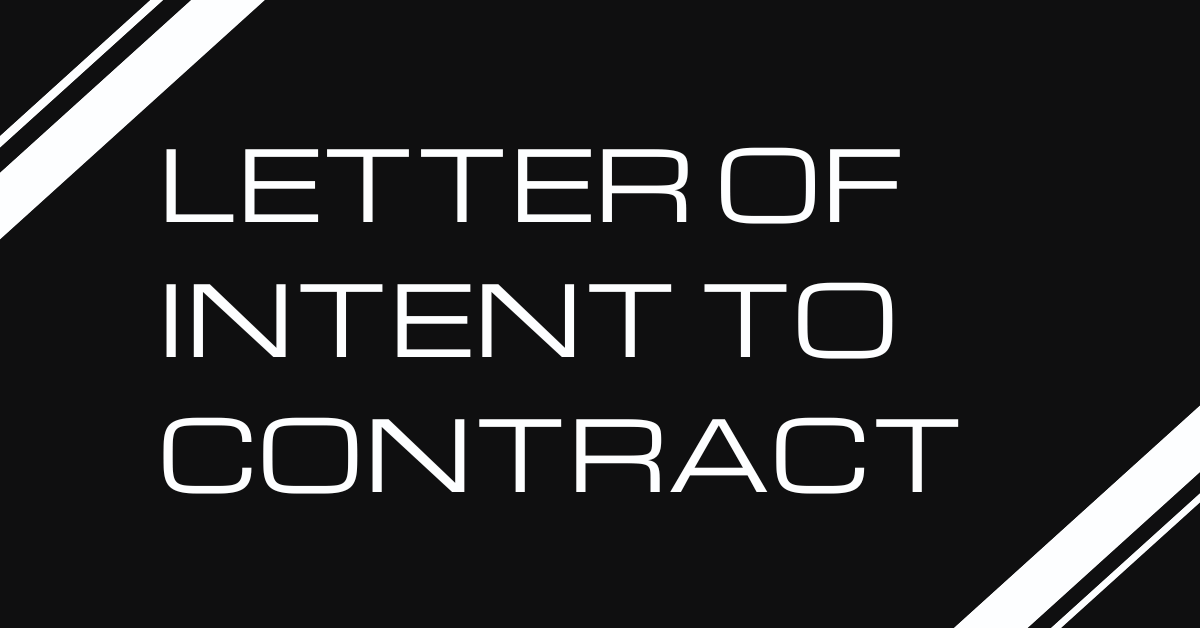A Letter of Intent to Contract is a formal document expressing an individual or organization’s intention to enter into a contractual agreement with another party. It outlines the basic terms and conditions of the proposed contract, serving as a preliminary agreement before the final contract are drafted and signed.
In this article, we’ll provide you with various templates, examples, and samples of Letter of Intent to Contract. Whether you’re a business owner, freelancer, or involved in any contractual negotiation, these resources will streamline the process of drafting your own letter. From simple agreements to more complex contracts, we’ve got you covered.
With our collection of Letter of Intent to Contract samples, you’ll have the tools you need to communicate your intentions clearly and professionally. Say goodbye to the hassle of starting from scratch, and let our templates guide you towards crafting effective and legally sound documents for your business endeavors.

Sample of a Letter Of Intent to Contract
[Your Name]
[Your Title/Position]
[Your Company/Organization]
[Date]
[Recipient’s Name]
[Recipient’s Title/Position]
[Recipient’s Company/Organization]
Dear [Recipient’s Name],
I am writing to express our sincere interest in entering into a formal contractual agreement with [Recipient’s Company/Organization]. As representatives of [Your Company/Organization], we believe that a mutually beneficial partnership between our entities would be advantageous and contribute positively to our respective goals and objectives.
After careful consideration and evaluation of our business needs and objectives, it is our intention to formalize our relationship through a comprehensive contract. This Letter of Intent serves as a preliminary step towards outlining the basic terms and conditions of the proposed agreement. We are committed to engaging in good faith negotiations to reach a mutually agreeable contract that meets the needs and expectations of both parties.
Outlined below are the key elements that we propose to include in the final contract:
- 1. Scope of Work: [Brief description of the scope of work or services to be provided]
- 2. Duration: [Proposed duration of the contract]
- 3. Payment Terms: [Details regarding payment schedule, rates, and any other financial considerations]
- 4. Responsibilities: [Allocation of responsibilities and obligations between the parties involved]
- 5. Termination Clause: [Conditions under which either party may terminate the contract]
We believe that a formalized contract will provide clarity, accountability, and protection for both parties involved. We are eager to commence discussions and negotiations to finalize the terms of the contract at the earliest convenience. Please feel free to reach out to discuss any questions or concerns you may have regarding this proposal.
Thank you for considering our proposal. We look forward to the opportunity to collaborate with [Recipient’s Company/Organization] and are confident that together, we can achieve great success.
Sincerely,
[Your Name]
[Your Contact Information]
How to Write a Letter Of Intent to Contract
In the realm of business dealings and legal agreements, crafting a Letter of Intent to Contract holds paramount importance. This document serves as a preliminary step toward solidifying a formal agreement between two or more parties. Whether you’re a seasoned entrepreneur or a novice freelancer, mastering the art of composing such a letter can significantly impact the success of your endeavors.
Understanding the Purpose
Before delving into the intricacies of drafting a Letter of Intent to Contract, it’s imperative to grasp its fundamental purpose. This document serves as a formal declaration of one party’s intention to engage in a contractual relationship with another. It outlines the basic terms and conditions that are intended to govern the forthcoming agreement, setting the stage for more detailed negotiations and discussions.
Identifying Key Components
To effectively communicate your intentions and expectations, it’s essential to identify and include key components within your Letter of Intent to Contract. These may include a clear statement of purpose, a brief description of the proposed agreement, the anticipated duration of the contract, and any pertinent terms and conditions that warrant attention. Additionally, specifying the desired outcome and objectives can help align the interests of all parties involved.
Structuring Your Letter
Structuring your Letter of Intent to Contract in a clear and concise manner is crucial for conveying your message effectively. Begin with a formal salutation, followed by a brief introduction stating the purpose of the letter. Next, articulate the key terms and conditions of the proposed agreement, using bullet points or numbered lists for clarity. Finally, conclude with a polite closing statement expressing your willingness to engage in further discussions and negotiations.
Emphasizing Clarity and Precision
Clarity and precision are paramount when drafting a Letter of Intent to Contract. Avoid ambiguity and vagueness in your language, opting instead for clear and unambiguous terms that leave little room for interpretation. Be specific when outlining the rights, obligations, and responsibilities of each party, and ensure that all terms are mutually understood and agreed upon.
Seeking Legal Counsel
While crafting a Letter of Intent to Contract, it’s advisable to seek legal counsel to ensure compliance with applicable laws and regulations. An experienced attorney can provide valuable guidance and assistance in drafting and reviewing the document, helping to mitigate potential risks and liabilities. Additionally, consulting with legal experts can offer peace of mind and assurance that your interests are adequately protected.
Reviewing and Revising
Before finalizing your Letter of Intent to Contract, take the time to review and revise the document thoroughly. Pay close attention to grammar, punctuation, and spelling errors, as well as inconsistencies or omissions in the content. Solicit feedback from trusted colleagues or advisors, and make any necessary revisions to ensure clarity, accuracy, and professionalism.
Conclusion
In conclusion, mastering the art of writing a Letter of Intent to Contract is a valuable skill for anyone engaged in business negotiations or contractual agreements. By understanding the purpose, identifying key components, and emphasizing clarity and precision, you can effectively communicate your intentions and expectations, setting the stage for a successful partnership or agreement. Remember to seek legal counsel, review and revise your letter diligently, and approach the process with patience and diligence. With careful planning and attention to detail, you can craft a compelling and persuasive letter that lays the groundwork for a mutually beneficial contractual relationship.
FAQs about a Letter Of Intent to Contract
When it comes to navigating the complexities of business agreements, understanding the intricacies of a Letter of Intent to Contract can be pivotal. Below, I’ve compiled the five most frequently asked questions regarding this crucial document, along with concise answers to provide clarity and guidance.
1. What is a Letter of Intent to Contract, and why is it important?
A Letter of Intent to Contract is a formal document expressing one party’s intention to enter into a contractual agreement with another. It serves as a preliminary step toward solidifying the terms and conditions of the proposed contract, providing a framework for further negotiations and discussions. Essentially, it lays the groundwork for a mutually beneficial partnership or agreement by outlining the basic terms and expectations of both parties.
2. What should be included in a Letter of Intent to Contract?
In a Letter of Intent to Contract, it’s essential to include key components such as a clear statement of purpose, a brief description of the proposed agreement, the anticipated duration of the contract, and any pertinent terms and conditions that warrant attention. Additionally, specifying the desired outcome and objectives can help align the interests of all parties involved, fostering a transparent and productive negotiation process.
3. Is a Letter of Intent to Contract legally binding?
While a Letter of Intent to Contract is not typically considered legally binding in itself, it can carry significant weight in legal proceedings, especially if it contains language indicating the parties’ intent to be bound by certain terms. However, it’s essential to seek legal advice to ensure that the language and content of the letter align with applicable laws and regulations, and to determine the extent of its enforceability.
4. How do I ensure clarity and precision in my Letter of Intent to Contract?
To ensure clarity and precision in your Letter of Intent to Contract, it’s crucial to avoid ambiguity and vagueness in your language. Be specific when outlining the rights, obligations, and responsibilities of each party, and use clear and unambiguous terms that leave little room for interpretation. Additionally, seek feedback from trusted colleagues or advisors, and revise the document diligently to ensure accuracy and professionalism.
5. What steps should I take before finalizing my Letter of Intent to Contract?
Before finalizing your Letter of Intent to Contract, it’s advisable to seek legal counsel to ensure compliance with applicable laws and regulations. An experienced attorney can provide valuable guidance and assistance in drafting and reviewing the document, helping to mitigate potential risks and liabilities. Additionally, take the time to review and revise the letter thoroughly, paying close attention to grammar, punctuation, and spelling errors, as well as inconsistencies or omissions in the content.
RELATED:
Letter to Cancel Service Contract
Business Name Change Letter to IRS
